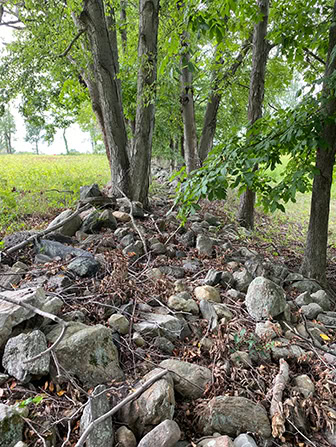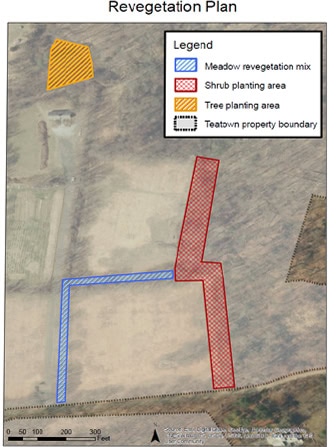Cliffdale Meadow Improvement Project
Over the past 70 years, post-agricultural land in the northeast has been developed or reforested, reducing the amount of available early successional habitat by 66%.
Early successional habitats are habitats dominated by herbaceous plants and shrubs, rather than mature trees. They are home to unique species of flora and fauna, providing important floral resources for pollinators and breeding habitat for grassland birds.
Grassland birds have been particularly impacted by this shifting landscape, as many species need a minimum of 10 acres of open grassland to safely nest. Cliffdale farm hosts a patchwork of small 1 to 4-acre fields that are separated by hedgerows and forest. The goal of this project is to join three of these small parcels to create one 10-acre field. Currently, the central rows of trees that divide these fields serve as predator traps where birds-of-prey, like red-tailed hawks, can hide in the trees and easily find the birds that are trying to nest. By removing the trees and shrubs along the hedgerows, grassland birds can safely build nests in the center of the fields.

Figure 1: Cliffdale current hedgerow with degraded
stone wall dividing fields.

Figure 2: Locations for 2021 plantings.
In addition to hedgerow work, this project also includes an altered mowing plan which will be adjusted around the breeding bird season to reduce nest disturbance. Several planting projects will take place to increase the biodiversity of meadow plants, creating transitions from the fields into the forest edges, and tree-planting will reforest a nearby canopy gap. This project was funded in part by a grant through the National Resource Conservation Service (NRCS), and our yearly operating budget.
FAQ
What bird species do you hope to see after this project is completed?
The Cliffdale fields host breeding American woodcock in the spring and we are hoping for increased breeding success with the completion of this project. Other species, like bobolinks, have minimum field sizes of about 10 acres to successfully nest and are not currently found at Teatown. The larger habitat space will encourage more grassland birds to nest while also improving the flyways for Eastern bluebirds. We are in the process of restoring nest boxes to further increase bluebird nesting success.
What happened to the stone walls?
The stone walls in the center of these fields were in poor condition. The stones had collapsed and created areas that were impossible to manage effectively without annual chemical treatments. The stones were moved to another area on site so they can be used in the future to repair other stone walls on the property.
What is early successional habitat?
Early successional habitat is open area that has not converted back to forest and requires regular management to keep trees from establishing. This habitat type includes grasslands, prairies, and shrub lands.
What are your long-term goals with this project?
Long term, Teatown would like to connect all the field patches on site, which would total nearly 50 acres of continuous early successional habitat. This would encourage the nesting of many more bird species and improve pollinator habitat. We also hope to reduce the bramble population in the fields, increase the diversity of native meadow plants, and increase the available food sources for birds by planting native shrubs in the transition zone between the fields and the forest.
What is a hedgerow? Why is it bad?
Hedgerows are rows of shrubs and trees that separate or border fields. Many of the hedgerows at Teatown grow around stone walls because those areas cannot be cut back or regularly managed. Hedgerows also create abrupt endings instead of gradual transitions. Transition zones are important wildlife habitat, providing food sources for grassland birds, and buffering harsh winds and sun from the forest interior.

